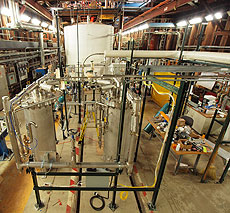A cheaper way to purify liquid argon for neutrino experiments
 |
|
The Liquid Argon Purity Demonstrator at Fermilab could help scientists cut costs for future neutrino experiments. Photo: Terry Tope
|
Today's high-end experiments are pushing scientists to invent new technologies to meet the demands of the next generation of physics. These innovations, however, must be balanced with creative cost-saving strategies. One expense currently under evaluation is the construction of liquid argon tanks, which play a vital role in sensitive neutrino experiments.
When neutrinos reach an experiment tank full of liquid argon, they interact with the nuclei in the argon and produce charged particles. Those particles spawn electrons that then drift toward an array of wire detectors. The distance the electrons drift, along with arrival information gathered from the wires, provides scientists with a detailed 3D reconstruction of the event.
In order to reduce the chance of those electrons interacting with other particles, the liquid argon should have the highest purity possible, with oxygen contamination levels that are only 100 parts per trillion. To achieve this level of purity, scientists often evacuate a tank to remove oxygen and water vapor before filling it with liquid argon. Making a tank that can withstand the complicated evacuation process is very expensive, as is the equipment to perform the evacuation.
Fermilab physicists Brian Rebel and Rob Plunkett, along with mechanical engineer Terry Tope, have led an effort over the last two years to design a new method to cut these costs. The innovative Liquid Argon Purity Demonstrator (LAPD) they engineered is the first system without evacuation that can achieve the necessary electron lifetimes for long drift distances.
The purification process begins with argon gas flowing into a tank that will eventually hold up to 30 tons of liquid argon. This pushes out ambient air. The gas is then recirculated throughout the entire system to further reduce contamination levels, while a heater dries the internal surfaces. When the desired purity level is achieved, Rebel and his team add liquid argon.
With a full tank, the recirculation begins. The liquid is pumped from the bottom of the tank through a maze of pipes and instruments, which include filters for separating water, oxygen and particulates from the argon. Eventually, the liquid returns to the bottom of the tank to restart the process. After eight hours, an entire tank volume is recirculated.
Insulation wrapped around the tank is part of a cryogenic cooling system that maintains a consistent low temperature of minus 186 degrees Celsius, keeping the argon in a liquid state.
"The real trick is this has never been done before," Rebel said. "There's nothing like this."
The bigger a tank is, the more neutrino interactions it can record. But the monetary tradeoff in building an evacuation-based vessel often limits the size of the tank and of the detector, compromising the capabilities of the experiment.
In large experiments, the LAPD system would have to recirculate the liquid argon to gain a level of purity high enough for 40 percent of the electrons to travel at least 2.5 meters to the readout wires without attaching to any positive ions within the argon. Electrons need 1.5 milliseconds to travel this distance, but a longer lifetime is necessary for minimizing electron losses.
As of late November, LAPD has consistently documented electron lifetimes of three milliseconds, easily meeting the team's goal. This means contamination in the tank has been successfully reduced to just 100 parts per trillion of oxygen.
"We are very happy with the results," Rebel said. "We couldn't have achieved them without the hard work of the people who contributed to the project."
—Brad Hooker
|